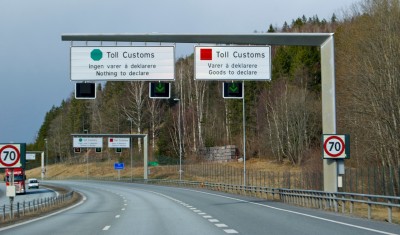Norwegian customs authorities, faced with a big increase in smuggling and other border crimes, want to expand a new automatic video surveillance system that’s led to an increase in seizures at border crossings in southeastern Norway. They think expansion and extension of the surveillance will give them a much better chance of cracking down on organized smuggling rings.

Cameras mounted at border crossings, especially the busiest one at Svinesund in southern Norway, already take photos of every single vehicle driving into Norway. Newspaper Aftenposten reported this week that alarms flash if certain license plates are found to be suspicious for various reasons, either because of unpaid vehicle registration, for example, or ties to earlier smuggling cases.
The vehicle in question can then be waved aside and subjected to thorough searches on the spot. The relatively new automatic control system has led to an increase of as much as 30 percent in the number of of seizures made by customs agents in Østfold County (southeastern Norway) alone.
It’s been in place at seven border crossings in Østfold: Svinesund, State Highway 118, Holtet, Berby, Kornsjø, County Highway 106 and Ørje. Now Customs Director Bjørn Røse wants to set up such digital surveillance at more border crossings around the country, and store the data on all vehicles driving into the country for much longer than they can now.
All the photos currently must be erased from the customs agency’s data base after just one hour, in line with national privacy regulations enforced by the state agency Datatilsynet. Officials at the customs agency (called Toll in Norway) think Datatilsynet’s rules are much too strict.
“We see a need for storing the data compiled at all border crossings for up to a year,” Røse told Aftenposten. “We also want to store information in the customs agency’s own systems on the vehicles and vehicle owners who are in violation.” Otherwise, Røse said, customs officials are losing “an important weapon in the fight against smuggling and other crimes.”
Wenche Fredriksen, head of the border station at Svinesund, supports Røse’s call and thinks the surveillance system would dramatically increase efficiency at all border crossings from Svinesund in the south to Grense Jakobselv in the north. She credits the surveillance system with cracking 18 major smuggling cases involving organized crime last year.
Aftenposten reported that in the course of just a half-hour last month, red lights flashed three times. In two of the alarms, the system picked up the license plate on a car from Poland that had been involved in earlier smuggling of alcohol, and on a Norwegian truck that was used in a smuggling case four years ago.
Officials at Datatilsynet, charged with restricting the registration and storage of personal data, said a change in the law would be needed to allow such an extension of data storage. Customs directors didn’t agree, but said if that’s true, they would ask for such a change.
Views and News from Norway/Nina Berglund
Please support our news service. Readers in Norway can use our donor account. Our international readers can click on our “Donate” button:

